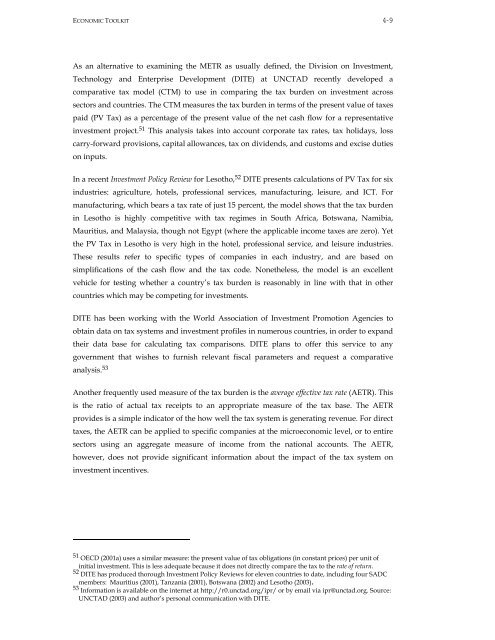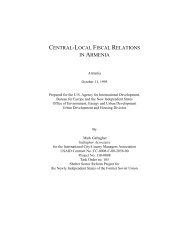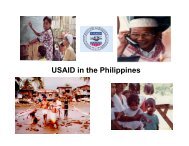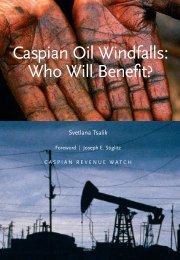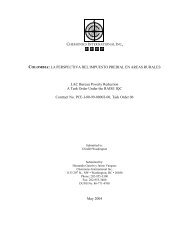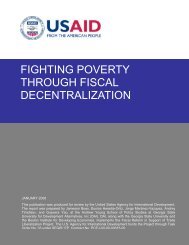Effectiveness and Economic Impact of Tax Incentives in the SADC ...
Effectiveness and Economic Impact of Tax Incentives in the SADC ...
Effectiveness and Economic Impact of Tax Incentives in the SADC ...
Create successful ePaper yourself
Turn your PDF publications into a flip-book with our unique Google optimized e-Paper software.
ECONOMIC TOOLKIT 4-9<br />
As an alternative to exam<strong>in</strong><strong>in</strong>g <strong>the</strong> METR as usually def<strong>in</strong>ed, <strong>the</strong> Division on Investment,<br />
Technology <strong>and</strong> Enterprise Development (DITE) at UNCTAD recently developed a<br />
comparative tax model (CTM) to use <strong>in</strong> compar<strong>in</strong>g <strong>the</strong> tax burden on <strong>in</strong>vestment across<br />
sectors <strong>and</strong> countries. The CTM measures <strong>the</strong> tax burden <strong>in</strong> terms <strong>of</strong> <strong>the</strong> present value <strong>of</strong> taxes<br />
paid (PV <strong>Tax</strong>) as a percentage <strong>of</strong> <strong>the</strong> present value <strong>of</strong> <strong>the</strong> net cash flow for a representative<br />
<strong>in</strong>vestment project. 51 This analysis takes <strong>in</strong>to account corporate tax rates, tax holidays, loss<br />
carry-forward provisions, capital allowances, tax on dividends, <strong>and</strong> customs <strong>and</strong> excise duties<br />
on <strong>in</strong>puts.<br />
In a recent Investment Policy Review for Lesotho, 52 DITE presents calculations <strong>of</strong> PV <strong>Tax</strong> for six<br />
<strong>in</strong>dustries: agriculture, hotels, pr<strong>of</strong>essional services, manufactur<strong>in</strong>g, leisure, <strong>and</strong> ICT. For<br />
manufactur<strong>in</strong>g, which bears a tax rate <strong>of</strong> just 15 percent, <strong>the</strong> model shows that <strong>the</strong> tax burden<br />
<strong>in</strong> Lesotho is highly competitive with tax regimes <strong>in</strong> South Africa, Botswana, Namibia,<br />
Mauritius, <strong>and</strong> Malaysia, though not Egypt (where <strong>the</strong> applicable <strong>in</strong>come taxes are zero). Yet<br />
<strong>the</strong> PV <strong>Tax</strong> <strong>in</strong> Lesotho is very high <strong>in</strong> <strong>the</strong> hotel, pr<strong>of</strong>essional service, <strong>and</strong> leisure <strong>in</strong>dustries.<br />
These results refer to specific types <strong>of</strong> companies <strong>in</strong> each <strong>in</strong>dustry, <strong>and</strong> are based on<br />
simplifications <strong>of</strong> <strong>the</strong> cash flow <strong>and</strong> <strong>the</strong> tax code. None<strong>the</strong>less, <strong>the</strong> model is an excellent<br />
vehicle for test<strong>in</strong>g whe<strong>the</strong>r a country’s tax burden is reasonably <strong>in</strong> l<strong>in</strong>e with that <strong>in</strong> o<strong>the</strong>r<br />
countries which may be compet<strong>in</strong>g for <strong>in</strong>vestments.<br />
DITE has been work<strong>in</strong>g with <strong>the</strong> World Association <strong>of</strong> Investment Promotion Agencies to<br />
obta<strong>in</strong> data on tax systems <strong>and</strong> <strong>in</strong>vestment pr<strong>of</strong>iles <strong>in</strong> numerous countries, <strong>in</strong> order to exp<strong>and</strong><br />
<strong>the</strong>ir data base for calculat<strong>in</strong>g tax comparisons. DITE plans to <strong>of</strong>fer this service to any<br />
government that wishes to furnish relevant fiscal parameters <strong>and</strong> request a comparative<br />
analysis. 53<br />
Ano<strong>the</strong>r frequently used measure <strong>of</strong> <strong>the</strong> tax burden is <strong>the</strong> average effective tax rate (AETR). This<br />
is <strong>the</strong> ratio <strong>of</strong> actual tax receipts to an appropriate measure <strong>of</strong> <strong>the</strong> tax base. The AETR<br />
provides is a simple <strong>in</strong>dicator <strong>of</strong> <strong>the</strong> how well <strong>the</strong> tax system is generat<strong>in</strong>g revenue. For direct<br />
taxes, <strong>the</strong> AETR can be applied to specific companies at <strong>the</strong> microeconomic level, or to entire<br />
sectors us<strong>in</strong>g an aggregate measure <strong>of</strong> <strong>in</strong>come from <strong>the</strong> national accounts. The AETR,<br />
however, does not provide significant <strong>in</strong>formation about <strong>the</strong> impact <strong>of</strong> <strong>the</strong> tax system on<br />
<strong>in</strong>vestment <strong>in</strong>centives.<br />
51 OECD (2001a) uses a similar measure: <strong>the</strong> present value <strong>of</strong> tax obligations (<strong>in</strong> constant prices) per unit <strong>of</strong><br />
<strong>in</strong>itial <strong>in</strong>vestment. This is less adequate because it does not directly compare <strong>the</strong> tax to <strong>the</strong> rate <strong>of</strong> return.<br />
52 DITE has produced thorough Investment Policy Reviews for eleven countries to date, <strong>in</strong>clud<strong>in</strong>g four <strong>SADC</strong><br />
members: Mauritius (2001), Tanzania (2001), Botswana (2002) <strong>and</strong> Lesotho (2003).<br />
53 Information is available on <strong>the</strong> <strong>in</strong>ternet at http://r0.unctad.org/ipr/ or by email via ipr@unctad.org. Source:<br />
UNCTAD (2003) <strong>and</strong> author’s personal communication with DITE.


